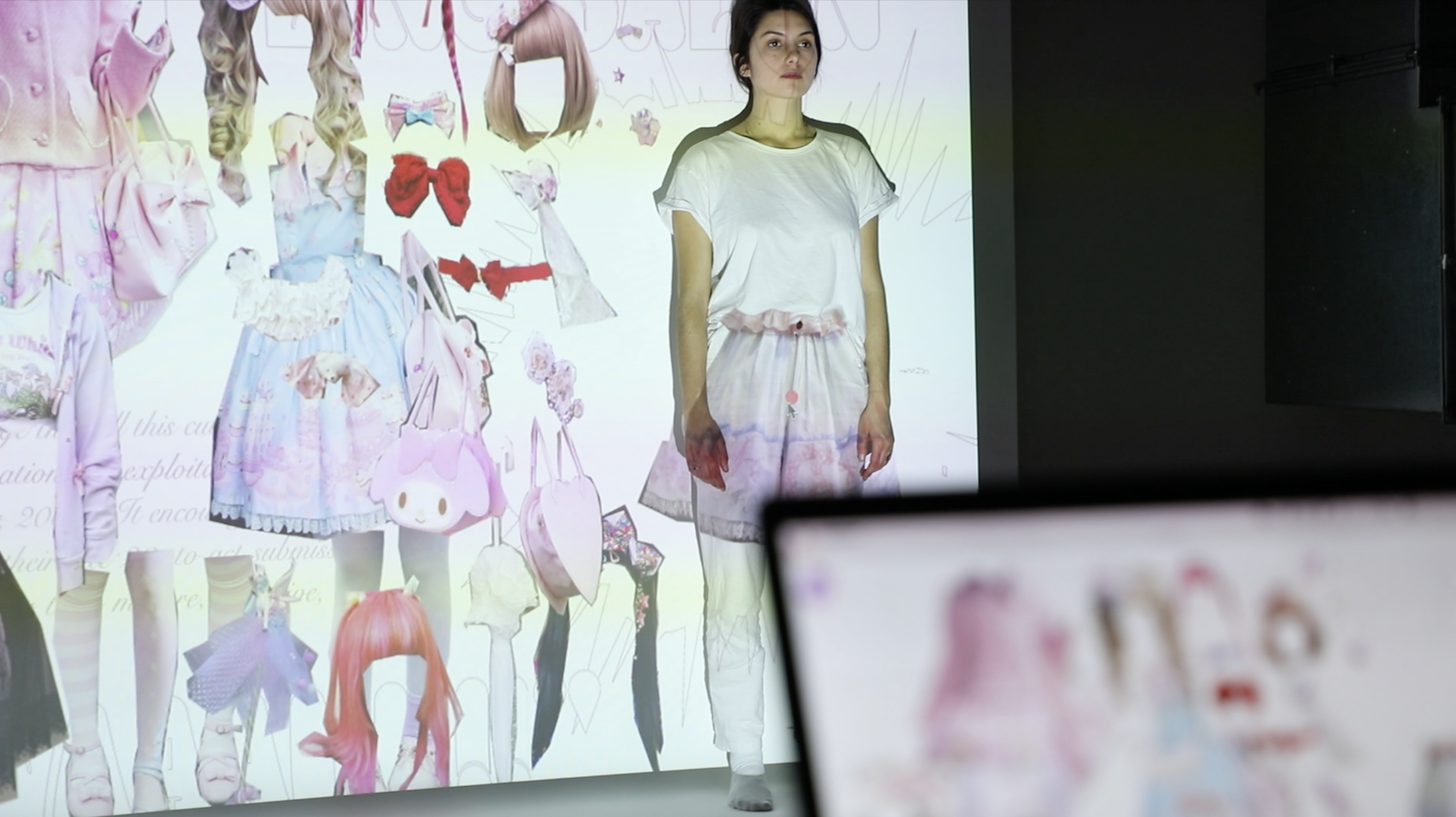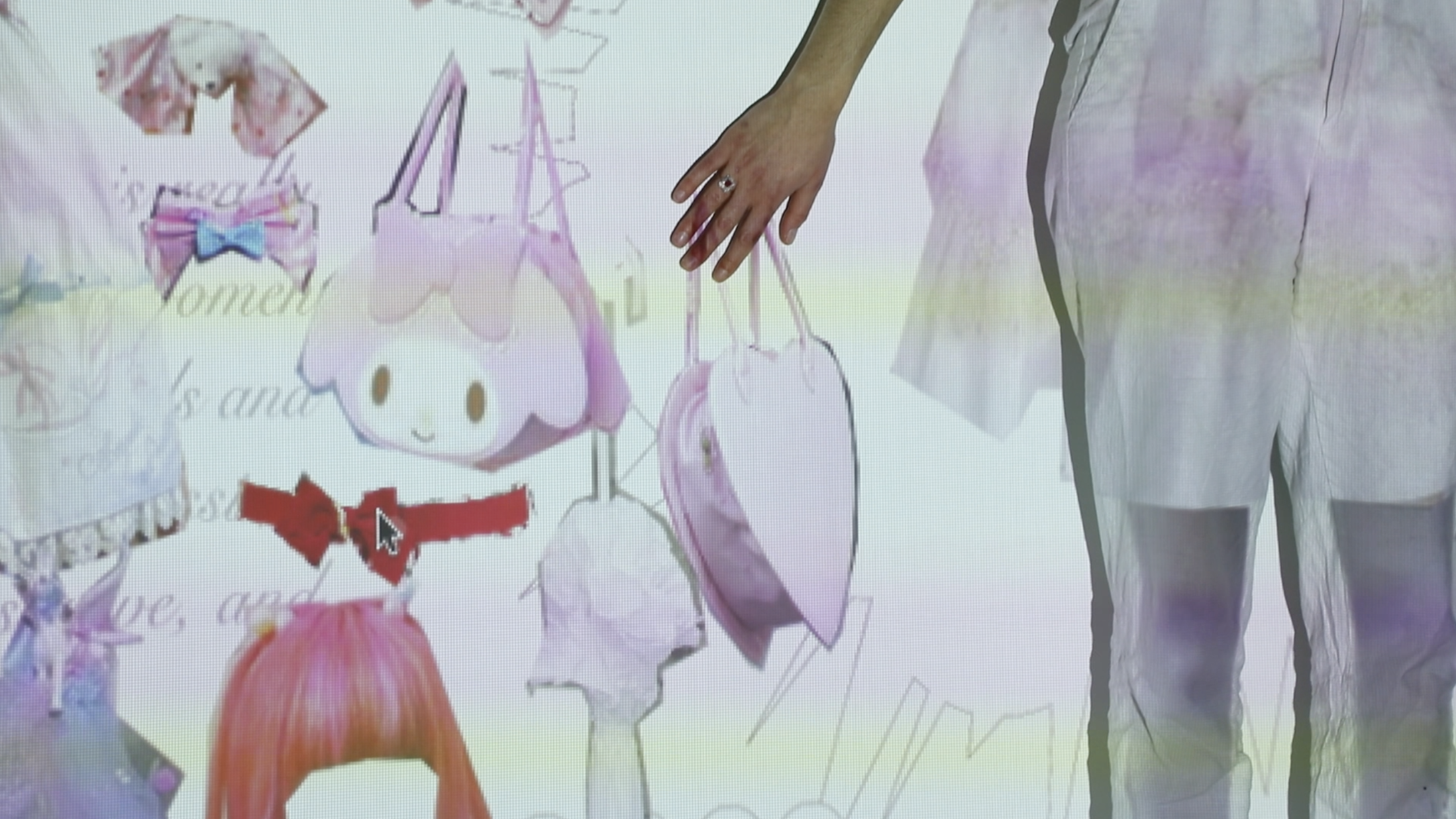
2018
Kawaii styling salon by Suzy Chan
Kawaii, means “cute” in Japanese. Within the last 30 years, cute has evolved from a Japanese cultural phenomenon into a ubiquitous chant among (female) teenagers: ‘‘that’s cute.’’
In my childhood, my favorite cartoon character was Hello Kitty. At that time, I was addicted to all Hello Kitty peripheral products. The purchase of Hello Kitty products can be considered as a trend in Asia. Later when I came to live in the West, the relationship between cute culture and
consumerism has risen my strong interest. I began to wonder if my previous obsession with Hello Kitty was from the trap of consumerism.
In this SIP project, I made a program by processing & projector mapping, collaborating with my friend Zheyun Chen. It is to express my position with cute culture and consumerism. When you participate in this program, you can dress your friends up via the projector (the one stands between the projector and white backdrop so as to get dressed up, or you could dress me up as I printed myself on a fabric, You can also just play in the interface. I am not ready to judge the culture but I engage the audience through open design and let them think about it. What I offer is a kind of awareness for cute culture and consumerism. Then I made two posters in order to present a relatively weird
feeling. Those posters reflect my attitude towards understanding and criticizing this culture.
Kawaii styling salon by Suzy Chan
Kawaii, means “cute” in Japanese. Within the last 30 years, cute has evolved from a Japanese cultural phenomenon into a ubiquitous chant among (female) teenagers: ‘‘that’s cute.’’
In my childhood, my favorite cartoon character was Hello Kitty. At that time, I was addicted to all Hello Kitty peripheral products. The purchase of Hello Kitty products can be considered as a trend in Asia. Later when I came to live in the West, the relationship between cute culture and
consumerism has risen my strong interest. I began to wonder if my previous obsession with Hello Kitty was from the trap of consumerism.
In this SIP project, I made a program by processing & projector mapping, collaborating with my friend Zheyun Chen. It is to express my position with cute culture and consumerism. When you participate in this program, you can dress your friends up via the projector (the one stands between the projector and white backdrop so as to get dressed up, or you could dress me up as I printed myself on a fabric, You can also just play in the interface. I am not ready to judge the culture but I engage the audience through open design and let them think about it. What I offer is a kind of awareness for cute culture and consumerism. Then I made two posters in order to present a relatively weird
feeling. Those posters reflect my attitude towards understanding and criticizing this culture.
2019
卡哇伊時尚沙龍 by Suzy Chan
卡哇伊,在日語中意為“可愛”。在過去的30年裡,可愛已經從日本的文化現象發展成為(女性)青少年中無處不在的頌歌:“這很可愛。”
在我童年時代,我最喜歡的卡通人物是Hello Kitty。那時,我沉迷於所有Hello Kitty周邊產品。購買Hello Kitty產品可被視為亞洲的趨勢。後來當我來到西方生活時,可愛文化和消費主義之間的關係引起了我的濃厚興趣。我開始懷疑自己以前對Hello Kitty的痴迷是不是來自於消費主義的陷阱。
在這個SIP項目中,我與我的朋友Zheyuan Chen合作,通過和投影儀繪圖製作了一個程序。這是用可愛的文化和消費主義表達我的立場。當你進入這個程序時,你可以通過投影儀給你的朋友打扮(一個站在投影儀和白色背景之間,以便打扮,或者你可以打扮我,因為我被打印在織物上,你也可以只是在界面中玩。)我不打算去評價這個文化,但是我通過開放的設計吸引觀眾,讓他們思考。我對可愛的文化和消費主義有一種認識。 我製作了兩張海報,以呈現一種相對奇怪的感覺。海報反映了我對這種文化既理解又批評的態度。
卡哇伊時尚沙龍 by Suzy Chan
卡哇伊,在日語中意為“可愛”。在過去的30年裡,可愛已經從日本的文化現象發展成為(女性)青少年中無處不在的頌歌:“這很可愛。”
在我童年時代,我最喜歡的卡通人物是Hello Kitty。那時,我沉迷於所有Hello Kitty周邊產品。購買Hello Kitty產品可被視為亞洲的趨勢。後來當我來到西方生活時,可愛文化和消費主義之間的關係引起了我的濃厚興趣。我開始懷疑自己以前對Hello Kitty的痴迷是不是來自於消費主義的陷阱。
在這個SIP項目中,我與我的朋友Zheyuan Chen合作,通過和投影儀繪圖製作了一個程序。這是用可愛的文化和消費主義表達我的立場。當你進入這個程序時,你可以通過投影儀給你的朋友打扮(一個站在投影儀和白色背景之間,以便打扮,或者你可以打扮我,因為我被打印在織物上,你也可以只是在界面中玩。)我不打算去評價這個文化,但是我通過開放的設計吸引觀眾,讓他們思考。我對可愛的文化和消費主義有一種認識。 我製作了兩張海報,以呈現一種相對奇怪的感覺。海報反映了我對這種文化既理解又批評的態度。











